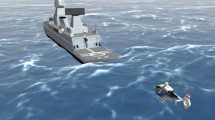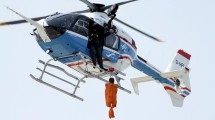Abstract
In this paper, operation of a helicopter near a ship is statistically investigated to provide an estimate of the probability of successfully recovering manned rotorcraft on the deck of a moving ship. To this end, pitch, roll, and heave motion of the ship are calculated according to sea states. In addition, effect on dynamics of the rotorcraft from ship airwake is also considered in a simplified way. By assuming that a helicopter can land on a ship if a pilot maintains relative position and attitude difference within the safe boundary for a given time, the operational limits are probabilistically determined in terms of pilot’s workload for a specified mission. The simulation environment consists of linearized helicopter dynamics, an optimal pilot model, effect of turbulent ship airwake, and ship motion. Control activities of the piloted helicopter for position holding with respect to the moving ship are transformed to generalized workload ratings. Simulation results show the proposed approach can evaluate and predict mission success rates for various operational combinations, allowing implementation into the overall effectiveness assessment of the ship and ship-helicopter combination.
Similar content being viewed by others
Abbreviations
- WOD :
-
Wind over the Deck
- CFD :
-
Computational Fluid Dynamics
- ADS :
-
Aeronautical Design Standard
- HQR :
-
Handling Quality Rating
- MTE :
-
Mission Task Element
- SHOL :
-
Ship/Helicopter Operating Limit
- PSD :
-
Power Spectral Density
- JONSWAP :
-
Joint North Sea Wave Project
- RMS :
-
Root Mean Square
- RPM :
-
Revolutions Per Minute
- OCM :
-
Optimal Control Model
- LQ :
-
Linear Quadratic
- WR :
-
Workload Rating
- CG :
-
Center of Gravity
References
D. Lee, N. Sezer-Uzol, J. Horn, and L. N. Long, “Simulation of helicopter shipboard launch and recovery with time-accurate airwake,” Journal of Aircraft, vol. 42, no. 2, pp. 448–461, March 2005.
J. V. Healy, “Establishing a database for flight in the wake of structures,” Journal of Aircraft, vol. 29, no. 4, pp. 559–564, 1992.
U. S. Army Aviation and Missile Defense Command, Aeronautical Design Standard, Performance Specification, Handling Qualities Requirements for Military Rotorcraft, U. S. Army Aviation and Missile Defense Command, Redstone Arsenal, AL, 2000.
S. K. Advani and C. H. Wilkinson, “Dynamic interface modeling and simulation — a unique challenge,” Proc. of Royal Aeronautical Society Conference on Helicopter Flight Simulation, November 2001.
J. Cooper, J. Schierman, and J. Horn, “Robust Adaptive Disturbance Compensation for Shipbased Rotorcraft,” Proc. of the AIAA Guidance, Navigation, and Control Conference, August 2010.
G. P. Turner, R. Bradley, and G. Brindley “Simulation of pilot control activity for the prediction of workload ratings in helicopter/ship operations,” Proc. of the 26th European Rotorcraft Forum, September 2000.
J. J. Jensen, A. E. Mansour, and A. S. Olsen, “Estimation of ship motion using closed-form expressions,” Ocean Engineering, vol. 31, no. 1, pp. 61–85, 2004.
K. J. Rawson and E. C. Tupper, Basic Ship Theory, Butterworth-Heinemann, Boston, MA, 2001.
J. N. Newman, “The theory of ship motions,” Advances in Applied Mechanics, vol. 18, pp. 221–283, 1978.
R. A. Hess, “Application of a model-based flight director design technique to a longitudinal hover task,” Journal of Aircraft, vol. 14, no. 3, pp. 265–271, 1977.
R. A. Hess, “Simplified technique for modeling piloted rotorcraft operations near ships,” Journal of Guidance, Control, and Dynamics, vol. 29, no. 6, pp. 1339–1349, 2006.
T. I. Fossen, Guidance and Control of Ocean Vehicles, John Wiley & Sons, Chichester, West Sussex, 1994.
G. D. Padfield, Helicopter Flight Dynamics: The Theory and Application of Flying Qualities and Simulation Modeling, AIAA, Reston, Virginia, 1996.
M. B. Tischler and M. G. Cauffman, “Frequencyresponse methods for rotorcraft system identification: flight applications to BO-105 coupled rotor/fuselage dynamics,” Journal of the American Helicopter Society, vol. 37, no. 1, pp. 3–17, 1992.
J. A. Lusardi, Control Equivalent Turbulence Inputs Model for the UH-60, Ph.D. Dissertation, Department of Mechanical and Aeronautical Engineering, University of California, Davis, 2004.
R. A. Hess, “A simplified and approximate technique for scaling rotor control inputs for turbulence modeling,” Journal of the American Helicopter Society, vol. 49, no. 3, pp. 361–366, 2004.
X. Yang, “Displacement motion prediction of a landing deck for recovery landing of rotary UAVs,” International Journal of Control, Automation, and Systems, vol. 11, no. 1, pp. 58–64, 2013.
R. J. Jagacinski and J. M. Flach, Control Theory for Humans-Quantitative Approaches to Modeling Performance, Erlbaum, Mahwah, NJ, 2003.
D. L. Kleinman, S. Baron, and W. H. Levison, “An optimal control model of human response part I: theory and validation,” Automatica, vol. 6, no. 3, pp. 357–369, 1970.
F. L. Lewis and V. L. Syrmos, Optimal Control, John Wiley & Sons, New York, NY, 1995.
D. M. Pool, P. M. T. Zaal, M. M. van Paassen, and M. Mulder, “Identification of multimodal pilot models using ramp target and multisine disturbance signals,” Journal of Guidance, Control, and Dynamics, vol. 34, no. 1, pp. 86–97, 2011.
C. A. Macdonald, The Development of an Objective Methodology for the Prediction of Helicopter Pilot Workload, Ph.D. Dissertation, Department of Mathematics, Glasgow Caledonian University, 2001.
R. Bradley, C. A. Macdonald, and T. W. Buggy, “Quantification and prediction of pilot workload in the helicopter/ship dynamic interface,” Proc. of the Institution of Mechanical Engineers, October 2005.
J. Cooper, J. Schierman, J. Horn, T. Yomchinda, and E. O’Neill, “Handling qualities evaluation of an adaptive disturbance compensation system for ship-based rotorcraft,” Proc. of the 67th American Helicopter Society Forum, May 2011.
J. Fletcher, A Model Structure for Identification of Linear Models of the UH-60 Helicopter in Hover and Forward Flight, NASA Technical Memorandum 110362, August 1995.
D. G. Mitchell, T. K. Nicoll, M. A. Fallon, and S. H. Roark, “Rotorcraft handling qualities for shipboard operations,” Proc. of AIAA Atmospheric Flight Mechanics Conference, August 2009.
Author information
Authors and Affiliations
Corresponding author
Additional information
Jongki Moon received his Ph.D. degree in Aerospace Engineering from the Georgia Institute of Technology, Atlanta in 2009. He has worked as Postdoctoral fellow at Aerospace Systems Design Laboratory in Georgia Tech. He also earned the B.S. and M.S. degrees in Aerospace Engineering from Seoul National University, Korea, in 1998 and 2000, respectively. His research interests include adaptive control, intelligent system, and multi-agent control.
Jean Charles Domercant is Research Faculty at the Georgia Institute of Technology School of Aerospace Engineering, where he oversees Defense & Space related research in the Aerospace Systems Design Laboratory (ASDL). He holds a BS in Aerospace Engineering (2000) from the University of Illinois Urbana-Champaign, an ME in Engineering Management (2006) from Old Dominion University, an MS in Aerospace Engineering (2008) and a Ph.D. in Aerospace Engineering (2011) from the Georgia Institute of Technology. His research interests include missile defense, technology portfolio selection, defense acquisitions and decision making, command & control and architecture-based systems-of-systems engineering.
Dimitri Mavris is the Boeing Regents Professor of Advanced Aerospace Systems Analysis at the Guggenheim School of Aerospace Engineering, Georgia Institute of Technology, and the director of its Aerospace Systems Design Laboratory (ASDL). Under Professor Mavris’ direction, ASDL performs wide-ranging technical research with a focus on the formulation, development and implementation of comprehensive approaches to the design of affordable and high quality complex systems using visual analytics and virtual experimentation. He received his B.S., M.S., and Ph.D. degrees in Aerospace Engineering from the Georgia Institute of Technology in 1984, 1985, and 1988, respectively.
Rights and permissions
About this article
Cite this article
Moon, J., Domercant, J.C. & Mavris, D. A simplified approach to assessment of mission success for helicopter landing on a ship. Int. J. Control Autom. Syst. 13, 680–688 (2015). https://doi.org/10.1007/s12555-013-0092-y
Received:
Revised:
Accepted:
Published:
Issue Date:
DOI: https://doi.org/10.1007/s12555-013-0092-y




